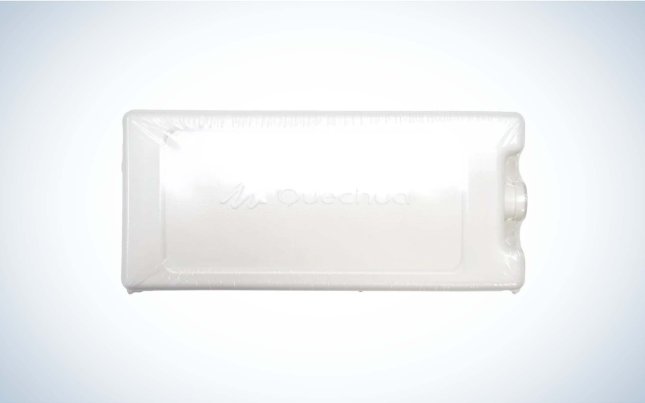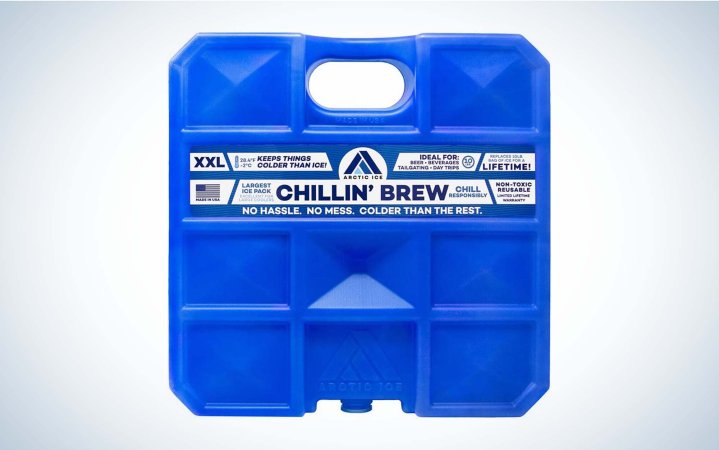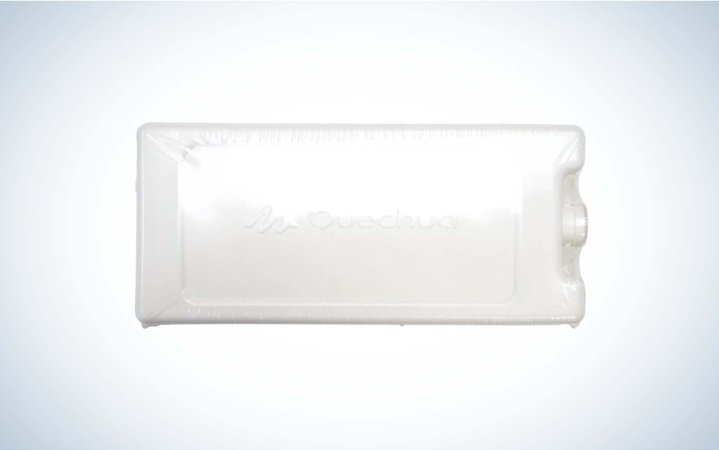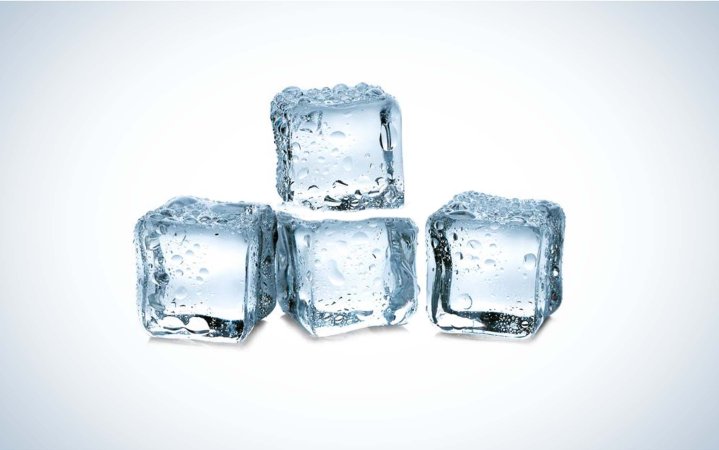We may earn revenue from the products available on this page and participate in affiliate programs. Learn More ›
It only takes pulling a wedge of waterlogged cheese out of your camping cooler once to realize the utility of a good ice pack. But with so many different brands on the market, it can be hard to know which is worth the investment and which is just taking up valuable real estate in your cooler. To help you choose the best ice packs for coolers for your next adventure, I tested seven of the most popular models by tracking their temperatures over ten hours at room temperature and 24 hours in a cooler.
- Best Overall: Ozark Trail -2 Degree Extra Cold Ice Substitute
- Most Versatile: Arctic Ice Chillin’ Brew
- Best Oversize: Igloo Maxcold
- Best Budget: Decathlon Quechua Hiking
- Most Eco-Friendly: Ice
How I Tested the Best Ice Packs for Coolers
I tested these reusable ice packs during the month of August. After freezing the ice packs for twenty-four hours, I took them out and placed them on the counter to measure their initial temperature using a household thermometer. After that, I recorded their temperature every hour to see how quickly their initial temperature dropped. Next, I refroze the ice packs (this time only overnight, or eight hours) and placed them inside one of the best camping coolers. After 24 hours I took the ice packs out to record their temperature. In addition to measuring the above performance, I also considered price, size, dishwasher safety, and their performance compared to both a regular ice cube and freebie reusable ice packs.

The Best Ice Packs for Coolers: Reviews & Recommendations
Best Overall: Ozark Trail -2 Degree Extra Cold Ice Substitute
Key Features
- Freezes at 28 degrees Fahrenheit
- Available in 2 pound and 4 pound sizes
- Dishwasher safe
Pros
- Colder than ice
- Low cost compared to other of the best ice packs for coolers
- Easy to clean
Cons
- Fewer available sizes than other brands we tested
If you’re looking for a high-quality ice pack on a limited budget, then the Ozark Trail brand is an excellent choice. It costs more than the Amazon Basics model, but during testing it held a lower temperature for longer than other low-price options (and significantly lower than the ice cube control). This pack stayed at freezing temperatures during the initial round of testing for over six hours. It was also well below freezing after spending 24 hours in a standard camping cooler.
The only drawback is that it comes in fewer sizes than other brands. But if you are looking for a few ice packs to keep your drinks chilled in a mid-sized cooler then this is a great value.
Most Versatile: Arctic Ice Chillin’ Brew
Key Features
- Freezes at 28 degrees Fahrenheit
- Available in .75 pound to 10 pound sizes
- Dishwasher safe
Pros
- Colder than ice
- Great size selection
Cons
- One of the more expensive ice packs in my test
Even though it wasn’t the top performing ice pack in the counter test, the Chillin’ Brew’s exceptional performance in the cooler test, as well as its wide variety of shapes and sizes (anywhere from 4 x 6 inches all the way up to 10 x 10 inches), makes this a smart pick for anyone looking to line the bottom of their cooler. When used in this way, the long-lived chill of the ice pack (which runs a few degrees below the freezing point of water) can refreeze any water that drips down to the bottom of the cooler, either from melting ice or even just condensation from your perishables.
For those looking to keep their goods frozen, Arctic Ice also makes an ice pack in their Tundra series that has a melting point of 15 degrees Fahrenheit, meaning the ice pack absorbs the heat that would otherwise affect your items with higher melting points.
Best Oversize: Igloo Maxcold
Key Features
- Freezes at 30 degrees Fahrenheit (as measured)
- Available in .5 pound to 5 pound sizes
- Hand wash
Pros
- Low price
- Colder than ice
Cons
- Not dishwasher safe
- Bulged out more than other ice packs in my test
The Igloo Maxcold was one of the most affordably priced ice packs in my test, making it an excellent choice for those looking to purchase larger ice packs in bulk to use in place of traditional ice.
This was the only ice pack in my test to develop a significant bulge in the middle, the consequence of the moisture inside of the ice pack expanding when it froze. While this bulge didn’t impact the integrity of the ice pack at all, it would make it more difficult to neatly stack in a cooler compared to other, more svelte, models. This ice pack also cannot be placed into a dishwasher to clean, unlike several of the others I looked at, making it more time-consuming to clean in the event of a cooler spill.
Best Budget: Decathlon Quechua Hiking
Key Features
- Freezes at 18 degrees Fahrenheit (per manufacturer); froze at 30 degrees Fahrenheit during testing
- One size only (comes in a pack of two)
- Hand wash
Pros
- Good chill retention for its size
- Low price
Cons
- No the coldest ice pack in my test
While the pint-sized Decathlon Quechua Hiking lost its chill rather quickly in the counter test, it was one of the coldest ice packs I measured after 24 hours in the cooler. While you’d need a (large) number of these to keep a bigger cooler at an appropriate chill, they’d work well for small coolers even in limited quantities. And if you do end up purchasing these in bulk for your next outdoor adventure, the single digit price tag would help ensure you had enough cash left over to fund one of the best camp kitchens around.
Most Eco-Friendly: Ice
Key Features
- Freezes at 32 degrees Fahrenheit
- Available in all sizes
- No cleaning required
Pros
- Low cost
- Easy to find on the go, or you can make your own at home
Cons
- Can waterlog your food
When preparing to test the best ice packs for coolers, one question kept coming up: are they actually any better than regular old ice? While the answer turned out to be yes (at least most of the time), I was impressed by how well ice cubes performed, easily staying below freezing for longer than several well-known brands. And not only can you always grab a bag or two from the nearest gas station (if you don’t have time to freeze them yourself before your trip), when they’ve outlived their usefulness, and are nothing more than a slurry of lukewarm water at the bottom of your cooler, you can just unscrew the drainage plug and let the water run out on the ground and return to the ecosystem—no special chemicals or plastics to worry about disposing of.
Things to Consider Before Buying the Best Ice Packs for Coolers

Desired Temperature
The best ice packs for coolers can get down to some surprisingly low temperatures—lower than -30 degrees Fahrenheit (the limit of what I could measure with one of the best infrared thermometers)—after solidifying in my freezer at its lowest setting. When packing beers in a cooler, the relative temperature is less important (most won’t freeze until they hit 28 degrees Fahrenheit or less), but if you are packing vegetables for several days, don’t overpack your cooler with ice packs, and be sure to utilize the storage containers to keep more sensitive items elevated above the coldest temperatures.
Size
Generally speaking, larger packs (or more of them) will keep the contents of your cooler colder for longer than smaller ones. If you plan to pair your ice pack with a bag (or two) of ice cubes from the store, then you’ll need fewer ice packs for coolers than if you use ice packs exclusively to chill your freezer.
Longevity
With anything that is meant to be unfrozen and refrozen multiple times, there is a risk that the plastic of the ice pack will end up degrading, and eventually break. In those instances, the contents of your cooler may be exposed to the liquid cooling substance inside the ice packs and, if not properly sealed, may have to be thrown away. Pay close attention to the plastic of your ice packs for coolers before each use to ensure that no fissures or cracks are starting to form.
FAQs
Ice packs for coolers typically cost between $5 and $20, with some sold as part of a pack of two or more.
While there isn’t too much to worry about if you are packing a cooler with beers or soda, packing a cooler with any or all perishable food that you plan to eat for the next few days can take a bit more planning. Start by putting any freezer packs that you intend to use at the bottom of the cooler. Next, add in items that you’d like to keep as cold as possible and that are unlikely to leak or spill—milk cartons, sodas, or beers.
You can also add meat to this layer, but be sure that it is tightly wrapped (ideally vacuum sealed). Add in a layer of ice here (if desired), and then pack on top fruits and vegetables that can sustain or respond well to freezing temps, such as blueberries or root vegetables (less accommodating produce can be placed on top of that). Utilize the pull-out drawer for your squishiest items, such as butter and cheese.
The number of ice packs you need for a cooler depends on how long you plan to be out for and whether you intend to utilize traditional bags of ice cubes. Generally, if you plan to be out for several days, it’s best to fill your cooler with two parts ice and ice packs to one part food and beverage. However, if you are simply looking to keep some beverages chilled for a summer barbeque, you can get away with a layer of ice packs at the bottom of the cooler and a couple of bags of ice.
Read Next: Best Coolers with Wheels
Final Thoughts on the Best Ice Packs for Coolers
After testing some of the best ice packs for coolers, I’m confident that the Ozark Trail brand is the best choice for most people. Arctic Ice’s excellent size range offers more temperature control for those with specific needs and the Igloo Maxcold delivers cold temperatures at a low price (albeit in an awkward shape). I also determined that while traditional bags of ice are an excellent option, the standard throwaway ice packs that come with food delivery services do not provide the level of performance that most individuals are looking for.








